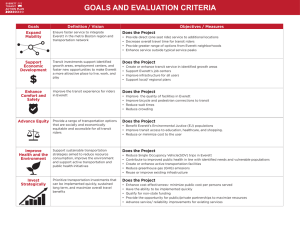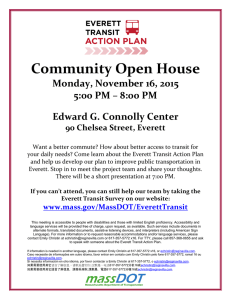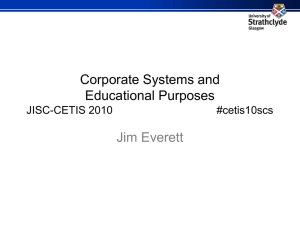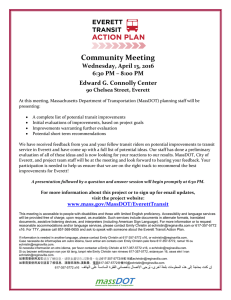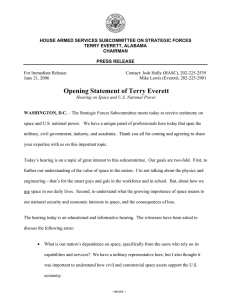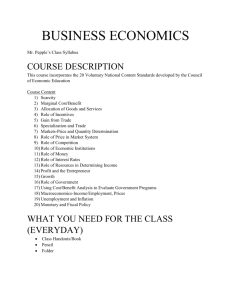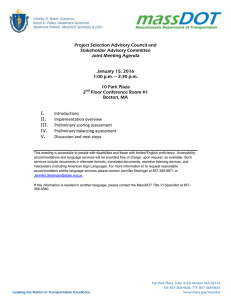Meeting Summary
advertisement
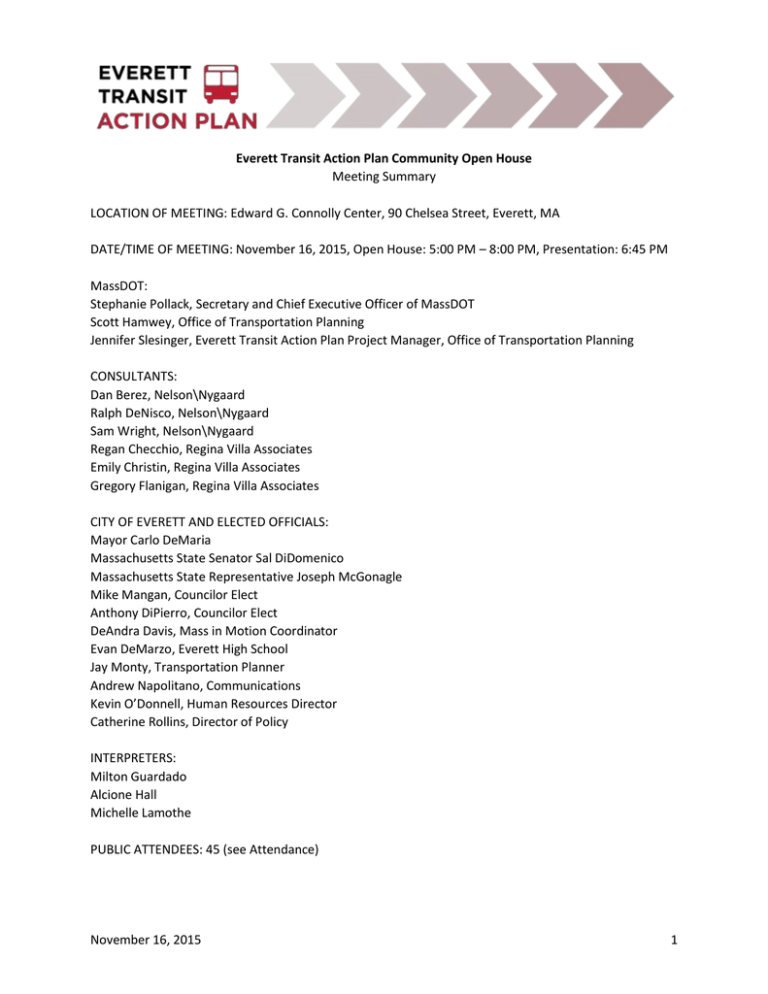
Everett Transit Action Plan Community Open House Meeting Summary LOCATION OF MEETING: Edward G. Connolly Center, 90 Chelsea Street, Everett, MA DATE/TIME OF MEETING: November 16, 2015, Open House: 5:00 PM – 8:00 PM, Presentation: 6:45 PM MassDOT: Stephanie Pollack, Secretary and Chief Executive Officer of MassDOT Scott Hamwey, Office of Transportation Planning Jennifer Slesinger, Everett Transit Action Plan Project Manager, Office of Transportation Planning CONSULTANTS: Dan Berez, Nelson\Nygaard Ralph DeNisco, Nelson\Nygaard Sam Wright, Nelson\Nygaard Regan Checchio, Regina Villa Associates Emily Christin, Regina Villa Associates Gregory Flanigan, Regina Villa Associates CITY OF EVERETT AND ELECTED OFFICIALS: Mayor Carlo DeMaria Massachusetts State Senator Sal DiDomenico Massachusetts State Representative Joseph McGonagle Mike Mangan, Councilor Elect Anthony DiPierro, Councilor Elect DeAndra Davis, Mass in Motion Coordinator Evan DeMarzo, Everett High School Jay Monty, Transportation Planner Andrew Napolitano, Communications Kevin O’Donnell, Human Resources Director Catherine Rollins, Director of Policy INTERPRETERS: Milton Guardado Alcione Hall Michelle Lamothe PUBLIC ATTENDEES: 45 (see Attendance) November 16, 2015 1 PURPOSE/SUBJECT: The purpose of this meeting was to: - Educate interested community members about the Everett Transit Action Plan - Present and receive feedback on initial findings related to demographics, natures of the existing transit service, and transit service gaps. - Engage with the community on priorities and major areas of concern. MEETING MATERIALS: PowerPoint Presentation (posted on project website) 8 Display Boards (posted on project website) Jars and Poker Chips for Transit Priorities Activity FORMAT: The meeting was arranged in an open house format with informational display boards set up around the room. Meeting attendees were encouraged to review the materials, talk to project staff, write comments on post-it notes, and participate in the Project Goals Activity. See “WRITTEN COMMENTS & ACTIVITIES SUMMARY” for more details, below. Upon entering the meeting, attendees were given five poker chips for the Project Goals Activity and three dot stickers to place on a display board. MassDOT delivered a brief presentation at approximately 7:00 PM followed by a discussion session. The open house format resumed after the presentation. SUMMARY OF PRESENTATION: Mayor Carlo DeMaria welcomed attendees and thanked them for attending. Mayor DeMaria introduced Stephanie Pollack, Secretary and Chief Executive Officer for the Massachusetts Department of Transportation (MassDOT). Secretary Pollack thanked everyone for inviting her to the Open House. She noted that the Everett Transit Action Plan represents a unique partnership between MassDOT and a local municipality. By working together, MassDOT and Everett can more quickly and effectively implement transportation improvements. Jennifer Slesinger, MassDOT Project Manager, thanked everyone for attending. Ms. Slesinger introduced the Everett Transit Action Plan and reviewed the agenda. She explained that the Everett Transit Action Plan project team is working closely with the City of Everett throughout this year-long study, and that recommendations from the Action Plan can directly feed the MBTA’s long-range investment plan for the MBTA that is currently under development. Ms. Slesinger reviewed other planning studies that are focused in the City of Everett. The project team will review the data from these other studies in conjunction with the Everett Transit Action Plan. Ms. Slesinger summarized the project tasks that have been completed to date, those that are ongoing, and future tasks. She noted various approaches that the Project Team has taken with regards to outreach November 16, 2015 2 including talking to residents at bus stops. Ms. Slesinger stressed that it is a priority for the project to connect with all facets of the Everett population and obtain as much feedback as possible. Ms. Slesinger outlined a potential menu of project goals and asked that attendees prioritize them as part of one of the open house activities. Ms. Slesinger presented the findings of the Existing Conditions data analyses. The Market Analysis– which looks at transit needs based off demographic information—showed that most areas in Everett have the population and employment density to support a transit service that runs only every 15 minutes, which is a lower level of service than what is provided today for much of the City. She explained that the population of Everett has a very high proportion of sub-groups that have a greater likelihood of taking transit compared with the average population on which the 15 minute frequency assumption is based. These populations include zero-vehicle households, persons with disabilities, lowincome households, and others. Ms. Slesinger reviewed the findings of the Service Analysis, and presented Route Profiles of the three bus routes that service Everett with the highest ridership activity: Routes 111, 104, and 109. The project staff observed a high amount of crowding on Route 109 buses, particularly on Sundays. Route 104 also showed crowding on buses. The frequency of Route 104 buses is not as great as other bus routes with similar ridership. Route 111 offers the only direct bus service to downtown Boston from Everett. There is only one stop in Everett along this route (at Woodlawn Cemetery), but it has the highest ridership numbers excluding the stops on Broadway. This shows the project team that there should be more opportunities for connections to downtown from Everett, as the demand is high. Ms. Slesinger summarized the Transit Observations that the project staff has observed so far. In the morning, Everett riders have very high service frequency to the Orange Line, as most can take almost any bus in either direction to reach a station. When riders are returning from the Orange Line, they must exit the Orange Line at Sullivan Square, Wellington, or Malden Center. Bus service back to Everett is divided between these three stations, resulting in longer wait times for the commute home. Ms. Slesinger pointed to maps showing that the available destinations of a two-seat (one transfer) bus ride from Everett differ greatly depending on whether you transfer at Sullivan Square or Wellington station. She also said that many of the major employers in Everett are poorly connected to the rest of the city, making access difficult for workers. The Everett Transit Action Plan will not only look at existing transportation modes, but will look at accessibility to main destinations. Ms. Slesinger showed a photo of a recent outreach event at the Everett High School football game. The project team has participated in several community events, interviewed commuters at Everett bus stops, and held stakeholder interviews. She presented highlights from Stakeholder Input that the project team has received so far. November 16, 2015 3 Ms. Slesinger outlined the Next Steps for the project. The team will look at alternatives for the short-, medium-, and long-term. The team is also hoping to use CharlieCard data to show origin and destination information, which has not been done before. Ms. Slesinger showed the transit primer, which was also a display board for Open House attendees to review. The primer is an overview of many of the types of transportation services that are available. She remarked that not every type of service will be appropriate for Everett. Ms. Slesinger reviewed the project timeline and the tasks to be completed over the next year, including public meetings. Ms. Slesinger shared the address of the project website, and asked all attendees to visit the website and take the Everett Transit Survey, if they have not done so already. She shared her contact information on the PowerPoint slide for attendees to reach out with further comments and questions. Ms. Slesinger encouraged them to participate in the activities and then opened up the floor for questions. DISCUSSION: A participant noted that a lot of people who live in Everett depend on transit services to go in the opposite direction of downtown Boston, such as Saugus or Malden, and urged the project team to look into this. Ralph DeNisco, Project Manager for Nelson\Nygaard, agreed and said the data observed so far supports that and shows that many trips from Everett are pointing north, even though most service in Everett is designed to go to Boston. An attendee commented that it is very difficult for disabled people to use public transportation and there should be a solution to this. She asked if The RIDE will be studied as part of this project. Ms. Slesinger responded that The RIDE is not being looked at as part of the Everett Transit Action Plan, but it is a part of the Focus40 long-term investment plan. The attendee added that one bus changed destinations mid-way through the route, standing several riders. A participant asked about the status of a proposed Rutherford Ave. closure. Mayor Carlo DeMaria said that the Mayor’s Office is coordinating with the City of Boston on the tunnel. Mr. DeNisco added that Focus40 will be looking at all existing studies and projects. He described the Regional Travel Demand model that will be used as part of this project, which will allow testing of various alternatives; for example, it will show the impacts to service in a particular area if a certain road is closed. MassDOT will use this tool when evaluating existing and potential projects. Mayor DeMaria asked if the final report from this project will include short-term solutions in addition to medium- and long-term solutions. Ms. Slesinger said it will. An attendee asked what data is used to produce the ridership activity. Mr. DeNisco said the data is based on a variety of sources including manual counts and Automated Passenger Count (APC) data. November 16, 2015 4 The participant said that he would not trust CharlieCard data because many riders use paper Charlie tickets and a lot of bus operators wave passengers on without collecting fares. He noted that has seen 109 buses at Sullivan Square station completely fill up and leave passengers who have waited up to an hour behind. Mr. DeNisco said the CharlieCard data is just one part of the ridership picture. The project team is looking at the whole market of riders and looking at the demand. He clarified that bus rider passenger counts come from the on-board APC system, which is a sensor, rather than CharlieCard data. Continual input from Everett commuters is important for the team to see if the data is accurate. An attendee commented that the 105 and the 97 buses only run until 6:30 PM, which has not changed for the last ten years, but there is enough ridership to fill the buses if more service is implemented. Ms. Slesinger said that at peak service hours, all MBTA buses are being used, so there are no extra buses to be put in service and additional revenue would be required to add bus drivers during the off-peak. Instead, the project team can look at re-routing buses that are in use at that time, which may be a shorter-term solution. Mayor DeMaria asked the team if they are seeing other areas that need fewer buses. Ms. Slesinger noted that as Secretary Pollack mentioned in her remarks, it had been some time since an Existing Conditions analysis has been done on the whole MBTA service area. The same conversation of needing more buses is being heard in almost every other community. Everett has a great opportunity with the Everett Transit Action Plan because MassDOT is specifically focusing on the city. Mr. DeNisco added that all attendees participating in the meeting are helping the study tremendously by providing feedback. A participant asked if it would make good fiscal sense to add more buses because they could generate more revenue. Mr. DeNisco said the study will look for opportunities to modify or add service, in part through an analysis of existing service productivity and usage. An attendee commented that the traffic circle at Broadway and Main Street is chaotic and asked the project team to look at solutions with timing of traffic signals or dedicated buses lanes, so the buses are not caught in traffic. Mr. DeNisco said the suggestions were excellent. Fixing traffic for buses to flow is a great solution and is going to be a large part of the alternatives development process. A participant stated that she knows a veteran who has trouble getting to where he needs to go. He needs to take the 110 bus and transfer to the 112, and it is very difficult for him. Mr. DeNisco said this project will look at hidden barriers to transportation. For example, there are many hills in Everett which make accessing certain bus stops difficult for disabled or senior commuters. Many jobs are being created in the industrial area of town, but that is hard to access as well. The project will examine these barriers. November 16, 2015 5 Ms. Slesinger thanked everyone for attending. ACTIVITIES & COMMENTS SUMMARY: Attendees placed three dot stickers on a display board that asked “What improvements would you like to see to MBTA service in Everett?” A total of 98 stickers were placed on the board. The improvement with the highest amount of stickers was “More Frequent Service,” which had 22 stickers. The results are shown in the following table. Improvements to MBTA Service Activity Results: Improvements: Total Dots More Frequent Service 22 Faster Service 8 Better On-Time Performance 15 Later Service Hours 16 Fewer Transfers 13 Less Crowding on Buses 11 More Benches and Shelters at Stops 13 Total 98 Percentage 22% 8% 15% 16% 13% 11% 13% Attendees were given five poker chips to participate in the Project Goals Activity. 10 jars were placed next to cards that each listed one project goal: 1. Sustain: transit as a part of a greener Everett. An example solution would be to provide transit services that relieve congestion and improve air quality. 2. Enhance: improve the user experience for riders. An example solution would be to improve access to bus stops and add shelters. 3. Do: find and complete investments immediately. An example solution would be short term improvements to immediately provide additional service. 4. Support: uses and users through Everett. An example solution would be to provide life line services for Everett residents. 5. Thrive: make Everett a more attractive place to live and work. An example solution would be to enhance the vitality of Everett’s local centers and neighborhoods. 6. Transform: use transit investments to foster development and change. An example solution would be to expand transit to emerging areas to support development and commerce. 7. Reach: create a broader range of direct connections from Everett. An example solution would be to add new direct routes to major destinations. 8. Accelerate: ensure faster service through Everett. An example solution would be to make roadway improvements for transit. 9. Integrate: transit with overall transportation system. An example solution would be effective transit as part of a range of mobility options. November 16, 2015 6 10. Connect: maximize connections using transit. An example solution would be to improve access to jobs and activities within and outside of Everett. Attendees placed their five chips in the Project Goals jars to vote on which goals are most important to them. They were allowed to place multiple chips in a single jar. The jars with the highest amount of chips were “Reach” and “Accelerate.” Both jars contained 28 chips. The results of the activity are shown in the table below. Project Goals Activity Results: Option Chips Percentage Sustain 23 11% Enhance 20 9% Do 19 9% Support 17 8% Thrive 25 12% Transform 18 8% Reach 28 13% Accelerate 28 13% Integrate 15 7% Connect 24 11% Total 217 Attendees were also encouraged to write comments on post-its and place them on the display boards. The table below contains post-it comments as well as oral comments from attendees to project team members during the Open House. Oral Comments and Written Comments on Post-its: Orange Line stop (between Wellington & Malden Center @ Little Creek) Ped/Bike bridge over Malden River to Riverside Ave. Pedestrian footbridge to Assembly New signal system on Orange Line to immediately increase capacity Sullivan Square connections are terrible Ped/Bike bridge to Somerville Pedestrian bridge to Assembly Express bus to downtown Future of Rutherford Avenue tunnel? Dedicated bus/carpool lane (on Broadway) Bridge across tracks to Gateway Center DMU to North Station November 16, 2015 7 Light rail from Everett Square to Wellington Commuter rail stop Station at casino; diesel multiple units Ped/Bike improvements at Santilli Circle More crosswalks at bus stops Connect Glendale/Everett to Route 111 into town Connection to the Silver Line Bus on Route 16 with ped/bike improvements Reduce the number of bus stops or have an express bus More bus shelters/benches everywhere Clean snow at bus stop Faster bus service on Broadway Bike lanes (Broadway north of Ferry) 111 is reliable & overcrowded 110 stinks; it isn't reliable at all More frequent service on 111 especially in reverse Better "The Ride" service Lower senior fares More frequent service on Route 110 Longer service hours for 112 Everett needs much more bus service in the many, many unserved/underserved areas Urban Ring: Logan-Chelsea-RR corridor-Rt 99-Sullvan Square-Somerville-McGrath-Lechmere-KendallCT2-BU Bridge-Longwood So many 93 running when 104 not coming at Sullivan Gateway Center - 97; bus running not late enough November 16, 2015 8 Everett Transit Action Plan Community Open House Attendance Claudia Ardon Machelin Ardon Christian Callcin Ralph D'Agostino Paul Degenkolb Harry M. Ells Jarod Evenson Malinda Formen Anthony Francis Mary Gerace Jack Gerace Dotty Gomez Antonio Guillen Trevor Hjoroge Silva Keytiana November 16, 2015 Felicita Lemus Jack McGrath Michael McLaughlin Rashaad McLennon Jackie Miller Gabriel Montresor Amelia Neve Cesar Nunes Kathleen O'Brien Alex O'Donnell Jo Oltman Yenise Oluwole David O'Neil Nativita Paul Michael R. Pritchard Wendy Pritchard Ron Ramsdell Jr. Nick Rand Joseph Raneri Patti Rogers Katy Rogers Katherine Rosa Mana Salgado David A. Senatillaka Daniel Skeritt Alessandra Souza Maria Valle Simret Woldecherkos 9
